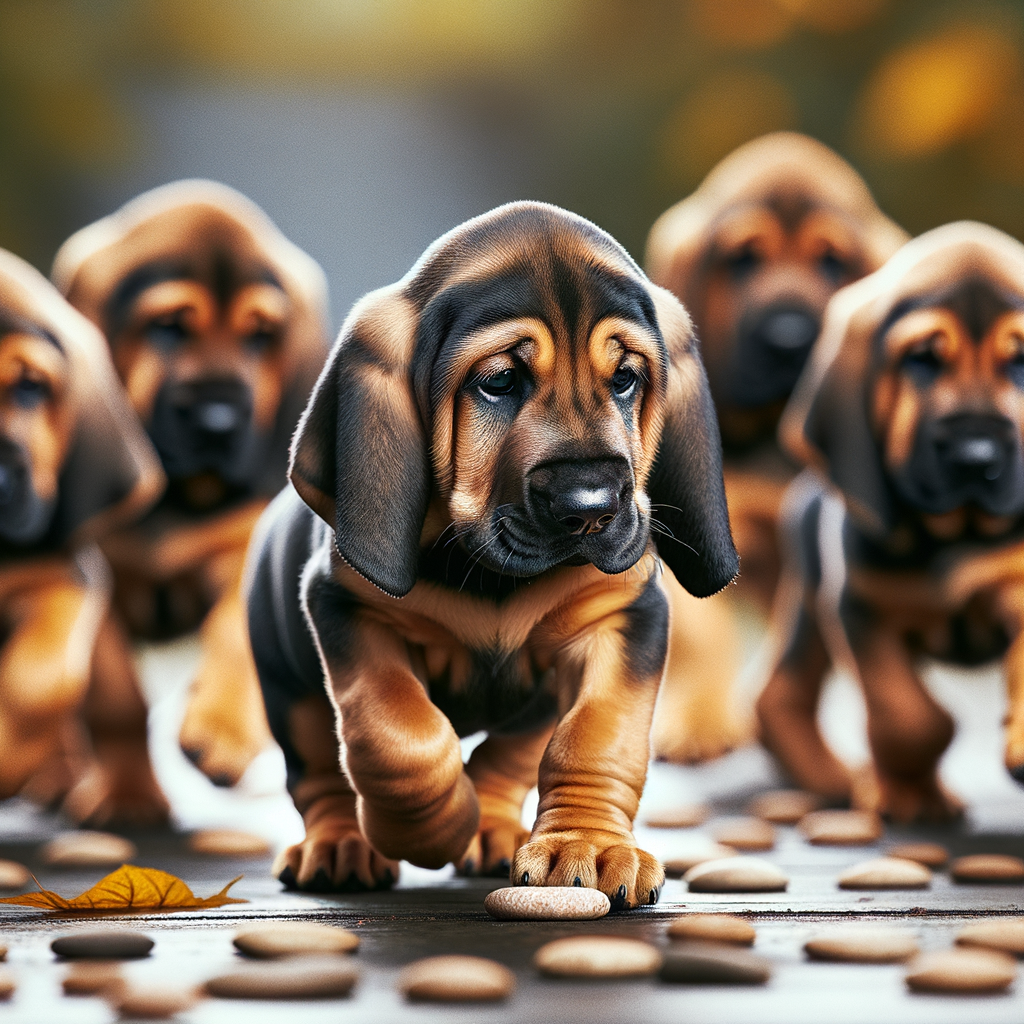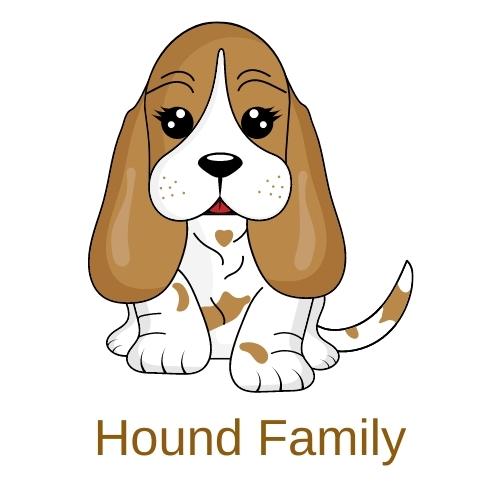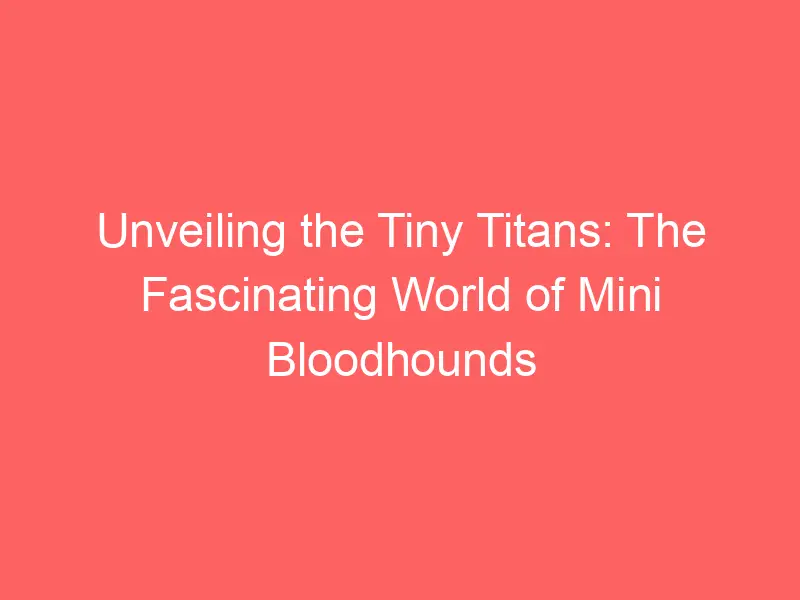
Introduction to Miniature Bloodhounds
Miniature Bloodhounds, a smaller version of the well-known Bloodhound breed, have captured the hearts of dog lovers worldwide. Despite their smaller size, these dogs carry the same charm, intelligence, and tracking abilities as their larger counterparts. This section will help you understand the breed and its history.
- Understanding the breed
- History and origin of Miniature Bloodhounds
Miniature Bloodhounds are a breed of scent hounds known for their keen sense of smell and tracking abilities. They are a smaller version of the traditional Bloodhound breed, typically weighing between 25-45 pounds and standing 13-15 inches tall. Despite their smaller size, they are just as energetic, loyal, and intelligent as their larger counterparts.
These dogs have a distinctive droopy appearance, with long ears and wrinkled skin. They have a short, dense coat that comes in a variety of colors, including black and tan, liver and tan, and red. Miniature Bloodhounds are known for their friendly and gentle nature, making them excellent companions for families and children.
The Bloodhound breed has a rich history that dates back to medieval times. They were originally bred for hunting in Belgium and France, and their excellent scent-tracking abilities quickly made them popular among hunters and law enforcement agencies.
The Miniature Bloodhound is a relatively new addition to the Bloodhound family. They were developed in the late 20th century by breeders who wanted to create a smaller, more manageable version of the Bloodhound that would be suitable for apartment living and for those who prefer smaller dogs. Despite their recent origin, Miniature Bloodhounds have quickly gained popularity due to their adorable appearance and friendly nature.
In the following sections, we will delve deeper into the fascinating world of Bloodhounds, explore the role of miniature tracking dogs, discuss Bloodhound training and care, and provide guidance on adopting Bloodhound puppies. Stay tuned to discover the joy of Miniature Bloodhounds!
The Fascinating World of Bloodhounds
Bloodhounds are a unique breed of dogs, known for their exceptional tracking abilities. They are a part of many fascinating stories and have a rich history. Let’s delve into the world of Bloodhounds and explore their different breeds, including the charming Miniature Bloodhounds.
Bloodhound Breeds
There are several types of Bloodhounds, each with their unique characteristics and traits. Let’s take a closer look at them.
- Overview of different Bloodhound breeds
- Characteristics of Miniature Bloodhounds
The Bloodhound breed is generally divided into two main types: the European Bloodhound and the American Bloodhound. The European Bloodhound is known for its larger size and heavier build, while the American Bloodhound is typically lighter and more agile. Both types share the same exceptional scent tracking abilities, making them valuable assets in search and rescue operations.
Miniature Bloodhounds, as the name suggests, are a smaller version of the traditional Bloodhound. Despite their smaller size, they retain the same keen sense of smell and tracking abilities as their larger counterparts. They are known for their friendly and sociable nature, making them excellent family pets. Miniature Bloodhounds are also easier to manage due to their smaller size, making them a popular choice for those living in apartments or smaller homes.
Whether you’re interested in a larger, more robust Bloodhound or a smaller, more manageable Miniature Bloodhound, there’s a Bloodhound breed to suit everyone’s lifestyle. These dogs are not only excellent trackers but also loyal and affectionate companions.
Small Bloodhounds vs Regular Bloodhounds
When it comes to the fascinating world of bloodhounds, size does matter. Let’s explore the differences between small bloodhounds and their regular-sized counterparts.
- Comparison of Physical Attributes
Small bloodhounds, often referred to as miniature bloodhounds, are a smaller version of the regular bloodhound breed. They typically weigh between 25 to 45 pounds, while regular bloodhounds can weigh anywhere from 80 to 110 pounds. The height of a small bloodhound ranges from 13 to 15 inches at the shoulder, whereas a regular bloodhound stands tall at 23 to 27 inches.
| Small Bloodhounds | Regular Bloodhounds | |
|---|---|---|
| Weight | 25-45 pounds | 80-110 pounds |
| Height | 13-15 inches | 23-27 inches |
- Comparison of Tracking Abilities
Despite their size, small bloodhounds are just as capable trackers as their larger counterparts. Both breeds have an exceptional sense of smell, second only to the Basset Hound. They can follow a scent trail that’s several days old over great distances. However, due to their smaller size, miniature bloodhounds may not be as effective in rough terrain as regular bloodhounds.
In a case study, a small bloodhound was able to track a lost child over three miles away, proving that their tracking abilities are not hindered by their size. Both small and regular bloodhounds are used in search and rescue operations due to their incredible tracking abilities.
In conclusion, while there are differences in physical attributes between small and regular bloodhounds, their tracking abilities are comparable. Choosing between the two would depend on your specific needs and circumstances.
Tiny Trackers: The Role of Miniature Tracking Dogs
Miniature Bloodhounds, also known as “Tiny Trackers”, play a significant role in various tracking activities. Despite their small size, these dogs possess an exceptional sense of smell and are capable of tracking scents over great distances. Let’s delve into the fascinating world of these miniature tracking dogs and see them in action.
- How Miniature Bloodhounds are used in tracking
Miniature Bloodhounds are primarily used in tracking due to their extraordinary sense of smell. They can pick up a scent trail that is several days old and follow it over long distances. This makes them ideal for finding lost pets, tracking down wildlife, and even assisting in search and rescue missions.
These tiny trackers are trained from a young age to recognize and follow specific scents. Their training involves a lot of play and rewards, making it a fun and engaging process for the dogs. Once they’ve picked up a scent, their determination and focus are unparalleled, often leading them straight to the source.
- Case studies of Miniature Bloodhounds in action
There are numerous instances where Miniature Bloodhounds have proven their tracking prowess. Let’s look at a couple of case studies:
Case Study Description Case 1: The Lost Cat In 2018, a Miniature Bloodhound named Bella helped locate a lost cat in Oregon. The cat had been missing for three days, but Bella was able to pick up its scent and track it down within a few hours. Case 2: The Missing Child In a more serious scenario, a Miniature Bloodhound named Max was instrumental in finding a missing child in Florida in 2020. The child had wandered off into a forest, but Max was able to track the child’s scent and lead rescuers to him within a day. These cases highlight the invaluable role that Miniature Bloodhounds play in tracking. Their keen sense of smell, combined with their determination and focus, make them excellent trackers.
Bloodhound Training
Training a bloodhound, especially a miniature one, requires patience and consistency. These dogs are known for their keen sense of smell and tracking abilities, which can be harnessed with the right training techniques.
Training Techniques for Miniature Bloodhounds
When it comes to training miniature bloodhounds, there are two main areas to focus on: basic obedience training and advanced tracking training. Let’s delve into each of these areas.
- Basic obedience training
- Advanced tracking training
Like any other dog, miniature bloodhounds need to learn the basics. This includes commands like sit, stay, come, and heel. These commands are not only important for the dog’s safety but also for its socialization and overall behavior.
Training should start as early as possible, ideally when the puppy is between 8 to 12 weeks old. Remember to keep the training sessions short and fun. Use positive reinforcement techniques such as treats, praise, and play to reward your dog for correctly following a command.
Once your miniature bloodhound has mastered the basics, you can move on to advanced tracking training. This is where the breed’s natural abilities really shine.
Start by creating a scent trail for your dog to follow. You can do this by dragging a scented object along the ground. At the end of the trail, place a reward for your dog to find. As your dog’s skills improve, you can make the trails longer and more complex.
Remember, training a miniature bloodhound requires patience and consistency. But with time and effort, your little tracker will be able to impress everyone with its skills.
Common Training Challenges
Training Miniature Bloodhounds can be a rewarding experience, but it’s not without its challenges. Let’s delve into some of the unique difficulties you might encounter and provide practical tips to overcome them.
- Understanding the unique challenges in training Miniature Bloodhounds
- Practical tips to overcome these challenges
- Consistency is key: Stick to a regular training schedule and use consistent commands. This helps your Miniature Bloodhound understand what is expected of them.
- Positive reinforcement: Reward your dog for good behavior. This could be in the form of treats, praise, or extra playtime. This encourages them to repeat the behavior.
- Patience: Remember, training takes time. Don’t expect immediate results. Be patient and persistent.
- Gentle handling: Due to their small size, Miniature Bloodhounds require gentle handling. Avoid harsh training methods.
Miniature Bloodhounds are intelligent and independent, but their strong sense of smell can sometimes distract them from training. They are also known for their stubbornness, which can make obedience training a bit of a challenge. Additionally, their small size means they may require more patience and gentle handling compared to larger breeds.
Here are some practical tips to help you navigate these challenges:
In conclusion, while training Miniature Bloodhounds can present unique challenges, with patience, consistency, and positive reinforcement, you can successfully train your tiny tracker. Remember, every dog is unique and what works for one might not work for another. So, be flexible and willing to adapt your training methods as needed.
Mini Bloodhound Care
When it comes to caring for your Miniature Bloodhound, one of the most important aspects to consider is their diet and nutrition. The food they consume plays a critical role in their overall health and their ability to perform their tracking duties.
Diet and Nutrition
Just like us, our furry friends need a balanced diet to stay healthy and active. But what exactly does a balanced diet for a Miniature Bloodhound look like?
- Recommended diet for Miniature Bloodhounds
- Importance of nutrition in maintaining health and tracking abilities
Miniature Bloodhounds require a diet rich in protein to support their muscle development and energy needs. They also need a good balance of carbohydrates for energy, and fats to keep their skin and coat healthy. Fruits, vegetables, and whole grains can provide the necessary vitamins, minerals, and fiber. It’s recommended to feed them high-quality commercial dog food that is appropriate for their age, size, and activity level. However, it’s always best to consult with your vet to create a diet plan that suits your dog’s individual needs.
Nutrition is not just about maintaining your Mini Bloodhound’s health, it’s also about enhancing their natural tracking abilities. A dog with a well-balanced diet will have the energy and focus necessary to follow a scent trail. Moreover, certain nutrients can help improve your dog’s sense of smell. For instance, Omega-3 fatty acids, found in fish and flaxseed, are known to boost brain health and potentially enhance sensory processing.
Remember, every dog is unique and what works for one might not work for another. Regular check-ups with your vet will ensure your Mini Bloodhound is getting the right nutrition and is in good health.
Health and Wellness
Keeping your Miniature Bloodhound healthy and happy is a top priority. Let’s delve into the common health issues these little trackers may face and how preventive care and regular check-ups can help maintain their wellness.
- Common health issues in Miniature Bloodhounds
Miniature Bloodhounds, like all breeds, can be susceptible to certain health conditions. While not all Miniature Bloodhounds will get any or all of these diseases, it’s important to be aware of them if you’re considering this breed.
| Health Issue | Description |
|---|---|
| Hip Dysplasia | This is a heritable condition where the thighbone doesn’t fit snugly into the hip joint. Some dogs show pain and lameness on one or both rear legs. |
| Ear Infections | Due to their long, droopy ears, Miniature Bloodhounds are prone to ear infections. Regular cleaning can help prevent this issue. |
| Obesity | Miniature Bloodhounds love to eat, and they can easily become overweight, which can lead to other health problems. |
- Preventive care and regular check-ups
Preventive care is crucial in maintaining your Miniature Bloodhound’s health. Regular veterinary check-ups can catch potential health issues early and keep your dog on track for a long, healthy life.
Here are some preventive measures you can take:
- Regular Exercise: Daily walks and playtime can help keep your Miniature Bloodhound’s weight in check and their joints healthy.
- Healthy Diet: A balanced diet is key to overall health. Ask your vet for diet recommendations based on your dog’s age, size, and activity level.
- Regular Vet Check-ups: Regular vet visits can help catch any potential health issues early. Your vet can also provide vaccinations and regular deworming treatments.
- Ear Care: Regularly clean your Miniature Bloodhound’s ears to prevent infections.
Remember, your Miniature Bloodhound is depending on you for their health and happiness. Regular care and preventive measures can ensure they live a long, healthy life.
Adopting Bloodhound Puppies
Adopting a bloodhound puppy is an exciting adventure, but it also requires careful consideration and preparation. Whether you’re a first-time dog owner or an experienced pet parent, it’s important to understand what you’re getting into. Let’s explore the key aspects to consider when adopting a miniature bloodhound and the responsibilities that come with owning one.
- What to consider when adopting a Miniature Bloodhound
- Space: These dogs are active and need plenty of space to run and play. Make sure you have a suitable home environment for them.
- Time: Bloodhounds require a lot of attention and interaction. Be prepared to spend quality time with your pet daily.
- Cost: Owning a dog isn’t cheap. From food to vet bills, be sure you can afford the ongoing expenses.
- Training: Bloodhounds are intelligent but can be stubborn. Training them requires patience and consistency.
- Understanding the responsibilities of owning a Miniature Bloodhound
- Healthcare: Regular vet check-ups, vaccinations, and preventative treatments are essential for your dog’s health.
- Exercise: Bloodhounds are energetic and need daily exercise to keep them healthy and happy.
- Nutrition: A balanced diet is key to your dog’s overall health. Make sure you’re feeding them high-quality dog food suitable for their age, size, and breed.
- Training and Socialization: Early training and socialization are crucial for your dog’s behavior and mental well-being. It’s your responsibility to ensure your Bloodhound is well-trained and gets along with other animals and people.
Miniature Bloodhounds are adorable, but they require a specific environment and care. Here are some factors to consider:
Being a pet parent is a long-term commitment. Here’s what you need to know about the responsibilities of owning a Miniature Bloodhound:
In conclusion, adopting a Miniature Bloodhound is a rewarding experience, but it’s not a decision to be taken lightly. By understanding what to consider when adopting and the responsibilities of owning one, you can ensure a happy and healthy life for your new furry friend.
Conclusion: The Joy of Miniature Bloodhounds
As we conclude our journey into the fascinating world of Miniature Bloodhounds, let’s take a moment to recap their unique qualities and reflect on the joy and challenges of owning these tiny trackers.
- Recap of the unique qualities of Miniature Bloodhounds
- Final thoughts on the joy and challenges of owning a Miniature Bloodhound
Miniature Bloodhounds, despite their small stature, are known for their exceptional tracking abilities. Their keen sense of smell, which is second only to the full-sized Bloodhound, allows them to excel in search and rescue operations. These little dogs are also known for their friendly and gentle nature, making them excellent companions. They are intelligent, easy to train, and adaptable to various living conditions. Their adorable appearance, with droopy ears and wrinkled skin, is simply the cherry on top!
Having a Miniature Bloodhound as a pet is a joy like no other. Their loyalty, intelligence, and affectionate nature make them a wonderful addition to any family. However, owning a Miniature Bloodhound is not without its challenges. Their energetic nature requires regular exercise and mental stimulation. Their keen sense of smell can sometimes lead them astray, so a secure yard is a must. Additionally, their droopy ears require regular cleaning to prevent infections.
In conclusion, the joy of owning a Miniature Bloodhound far outweighs the challenges. Their unique qualities and lovable nature make them a joy to have around. So, if you’re considering adopting a Miniature Bloodhound, remember that with the right care and training, these tiny trackers can bring immense joy and companionship into your life.








